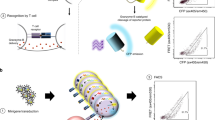Abstract
Listeria monocytogenes is a Gram-positive bacterium which grows in the cytoplasm of eukaryotic cells and can cause severe disease in immunocompromised individuals1,2. In murine systems CD8+T lymphocytes have been shown to be important effectors of acquired protective immunity against L. monocytogenes3–5. Class I MHC-restricted CD8+ cytotoxic T lymphocytes (CTL), which lyse J774 macrophage-like targets infected with L. monocytogenes, are induced following in vivo injection of live organisms. Natural peptide epitopes derived from L. monocytogenes can be acid-extracted from heavily infected BALB/c spleens and detected by CTL. A CTL clone, B9, derived from a (BALB/c x C57BL/6)F1 (H–2dxb) mouse, recognizes one of these natural epitopes in an H–2Kd-restricted fashion. B9 also recognizes P815 (H–2d) mas-tocytoma cells transfected with the listeriolysin gene. To identify the region of the listeriolysin recognized by CTL we used the H–2Kd peptide-binding motif described by Rammensee and colleagues6 to synthesize 11 nonamer peptides. One of these peptides, listeriolysin 91–99, was recognized very efficiently by B9. This represents the first identified class I MHC-restricted epitope of bacteria and demonstrates the utility of the allele-specific motif for predicting CTL epitopes.
This is a preview of subscription content, access via your institution
Access options
Subscribe to this journal
Receive 51 print issues and online access
$199.00 per year
only $3.90 per issue
Buy this article
- Purchase on Springer Link
- Instant access to full article PDF
Prices may be subject to local taxes which are calculated during checkout
Similar content being viewed by others
References
Tilney, L. G. & Portnoy, D. A. J. Cell Biol. 109, 1597–1608 (1989).
Marget, W. & Seeliger, H. P. R. Infection 16, 175–177 (1988).
Kaufmann, S. H. E., Hug, E. & DeLibero, G. J. exp. Med. 164, 363–368 (1986).
Bishop, D. K. & Hinrichs, D. J. J. Immun. 139, 2005–2009 (1987).
Mielke, M. E. A., Ehlers, S. & Hahn, H. Infect. Immun. 56, 1920–1925 (1988).
Falk, K., Roetzschke, O., Stevanovic, S. Jung, G. & Rammensee, H.-G. nature 351, 290–296 (1991).
Mackaness, G. B. J. exp. Med. 116, 381–406 (1962).
Gaillard, J. L., Berche, P. & Sansonetti, P. Infect. Immun. 52, 50–55 (1986).
Kathariou, S., Metz, P., Hof, H. & Goebel, W. J. Bact. 169, 1291–1297 (1987).
Portnoy, D. A., Jacks, P. S. & Hinrichs, D. J. J. exp. Med. 167, 1459–1471 (1988).
Pine, L. et al. J. clin. Microbiol. 25, 2247–2251 (1987).
Brunt, L. M., Portnoy, D. A. & Unanue, E. R. J. Immun. 145, 3540–3546 (1990).
DeLibero, G. & Kaufmann, S. H. E. J. Immun. 137, 2688–2694 (1986).
Lukacs, K. & Kurlander, R. J. J. Immun. 143, 3731–3736 (1989).
Van Bleek, G. M. & Nathenson, S. G. Nature 348, 213–216 (1990).
Roetzschke, O. et al. Nature 348, 252–254 (1990).
Mengaud, J. et al. Infect. Immun. 56, 766–772 (1988).
Safley, S. A., Cluff, C. W., Marshall, N. E. & Ziegler, H. K. J. Immun. 146, 3604–3616 (1991).
Berche, P., Gaillard, J., Geoffrey, C. & Alouf, J. E. J. Immun. 139, 3813–3821 (1987).
Deres, K., Schild, H., Wiesmueller, K., Jung, G. & Rammensee, H.-G. Nature 342, 561–564 (1989).
Aichele, P., Hengartner, H., Zinkernagel, R. F. & Schulz, M. J. exp. Med. 171, 1815–1820 (1990).
Kast, M. et al. Proc. natn. Acad. Sci. U.S.A. 88, 2283–2287 (1991).
Moore, M. W., Carbone, F. R. & Bevan, M. J. Cell 54, 777–785 (1988).
Roetzschke, O., Falk, K., Wallny, H.-J., Faath, S. & Rammensee, H.-G. Science 249, 283–287 (1990).
Ozato, K., Mayer, N. M. & Sachs, D. H. Transplantation 34, 113–120 (1982).
Gunning, P., Leavitt, J., Muscat, G., Sun-Yu, N. & Kedes, L. Proc. natn. Acad. Sci. U.S.A. 84, 4831–4835 (1987).
Author information
Authors and Affiliations
Rights and permissions
About this article
Cite this article
Pamer, E., Harty, J. & Bevan, M. Precise prediction of a dominant class I MHC-restricted epitope of Listeria monocytogenes. Nature 353, 852–855 (1991). https://doi.org/10.1038/353852a0
Received:
Accepted:
Issue Date:
DOI: https://doi.org/10.1038/353852a0
This article is cited by
-
Listeria monocytogenes: a model pathogen to study antigen-specific memory CD8 T cell responses
Seminars in Immunopathology (2015)
-
In silico quantitative prediction of peptides binding affinity to human MHC molecule: an intuitive quantitative structure–activity relationship approach
Amino Acids (2009)
-
Identification of a new HLA-A*0201-restricted cytotoxic T lymphocyte epitope from CML28
Cancer Immunology, Immunotherapy (2006)
-
CD8+ T cell contraction is controlled by early inflammation
Nature Immunology (2004)
Comments
By submitting a comment you agree to abide by our Terms and Community Guidelines. If you find something abusive or that does not comply with our terms or guidelines please flag it as inappropriate.



